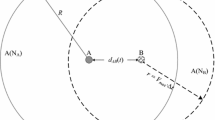Abstract
Mobile Ad Hoc Networks (MANETs) consist of several nodes that are mobile in nature. The random and unpredictable node mobility in MANETs has negative impact on the network performance as it makes the network prone to frequent link breakages which increase packet loss and control overhead. Reliable MANET can be achieved through fast link failures detection that enables fast notification to be delivered to sources in order to make proper reaction. Therefore, the research work in this paper presents an effective topology-aware method, called Route Failure Prediction (RFP), which predicts the link breakage before it actually occurs in source routing networks. A node that utilizes RFP divides the area within transmission range into regions based on the signal strength received from neighbors. It calculates the changing rate of its location and update the upstream node if it is about to move out of the transmission range to avoid communication disruption. The performance of RFP was evaluated using ns-2 and compared to that of DSR. The experimental results gained from simulations were analyzed in terms of Packet Delivery Ratio (PDR), Control Overhead (COH), and the End-to-End Delay with respect to the number of events of link breakage happened during the experiments. The numerical results showed that RFP outperforms DSR significantly and offers reliable data transfer between sources and destinations.
Access this chapter
Tax calculation will be finalised at checkout
Purchases are for personal use only
Similar content being viewed by others
Notes
- 1.
In this paper, the terms parent and upstream node are used interchangeably to refer to the node that data is received from over an active link.
References
Abusubaih M, Rathke B, Wolisz A (2007) A dual distance measurement scheme for indoor ieee 802.11 wireless local area networks. In: 9th IFIP international conference on mobile wireless communications networks, 2007, pp 121–125, Sept 2007
Wan Z (2011) Commercial issues in hybrid cellular-ad hoc networks. In: Fifth international conference on Management of e-Commerce and e-Government (ICMeCG), pp 226–228, Nov 2011
Khudayer BH, Kadhum MM, Chee WT (2015) Multi-disjoint routes mechanism for source routing in mobile ad-hoc networks. In: Submitted to ICISA2015: international conference on information science and applications, Pattaya, Thailand. Springer Lecture Notes in Electrical Engineering series (LNEE). 24th–26th Feb 2015
Boukerche A (2004) Performance evaluation of routing protocols for ad hoc wireless networks. Mob Netw Appl 9(4):333–342
Rohankar R, Bhatia R, Shrivastava V, Sharma DK (2012) Performance analysis of various routing protocols (proactive and reactive) for random mobility models of adhoc networks. In: 2012 1st international conference on Recent Advances in Information Technology (RAIT), pp 331–335, Mar 2012
Khudayer BH, Kadhum MM (2014) Reliability of dynamic source routing in heterogeneous scalable mobile ad hoc networks. In: IEEE international conference on communication, networks and satellite—COMNESAT, pp 71–79, Jakarta, Indonesia. Institute of Electrical and Electronics Engineers (IEEE), 4–5 Nov 2014
Johnson DB, Maltz DA, Broch J (2000) DSR: the dynamic source routing protocol for multihop wireless ad hoc networks. In: Ad hoc networking. Addison-Wesley Longman Publishing Co., Inc., Boston, pp 139–172, Dec 2000
Willsky, A (1976) A survey of design methods for failure detection in dynamic systems. Automatica 12:601–611
Acknowledgments
This work was supported by National Advanced IPv6 Centre of Excellence (NAv6), Universiti Sains Malaysia (USM).
Author information
Authors and Affiliations
Corresponding author
Editor information
Editors and Affiliations
Rights and permissions
Copyright information
© 2016 Springer International Publishing Switzerland
About this paper
Cite this paper
Khudayer, B.H., Kadhum, M.M., Wan, TC. (2016). Topology-Aware Mechanism to Improve Routing in Mobile Ad Hoc Networks. In: Soh, P., Woo, W., Sulaiman, H., Othman, M., Saat, M. (eds) Advances in Machine Learning and Signal Processing. Lecture Notes in Electrical Engineering, vol 387. Springer, Cham. https://doi.org/10.1007/978-3-319-32213-1_2
Download citation
DOI: https://doi.org/10.1007/978-3-319-32213-1_2
Published:
Publisher Name: Springer, Cham
Print ISBN: 978-3-319-32212-4
Online ISBN: 978-3-319-32213-1
eBook Packages: EngineeringEngineering (R0)




